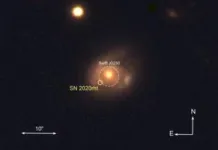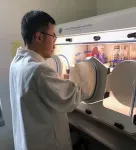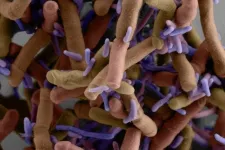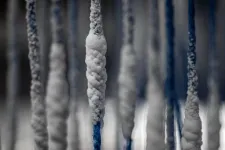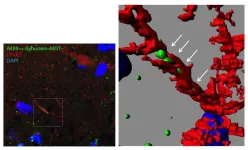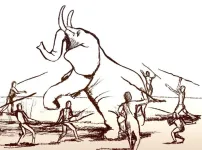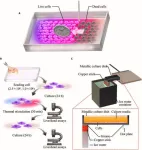(Press-News.org) A star like our own Sun in a nearby galaxy is gradually being eaten away by a small but ravenous black hole, losing the equivalent mass of three Earths every time it passes close.
The discovery by University of Leicester astronomers is reported today (7 September) in Nature Astronomy and provides a ‘missing link’ in our knowledge of black holes disrupting orbiting stars. It suggests a whole menagerie of stars in the process of being consumed that still lie undiscovered.
The team was supported by the UK Space Agency and the UK Science and technology Facilities Council (STFC).
The astronomers were alerted to the star by a bright X-ray flash that seemed to come from the centre of the nearby galaxy 2MASX J02301709+2836050, around 500 million light-years away from the Milky Way. Named Swift J0230, it was spotted the moment it happened for the first time using a new tool developed by the scientists for the Neil Gehrels Swift Observatory. They rapidly scheduled further Swift observations of it, finding that instead of decaying away as expected, it would shine brightly for 7-10 days and then abruptly switch off, repeating this process roughly every 25 days.
Similar behaviour has been observed in what are termed quasi-periodic eruptions and periodic nuclear transients, where a star has material ripped away by a black hole as its orbit takes it close by, but they differ in how often they erupt, and in whether it is in X-rays or optical light that the explosion is predominant. The regularity of Swift J0230’s emissions fell between the two, suggesting that it forms the ‘missing link’ between the two types of outburst.
Using the models proposed for these two classes of event as a guide, the scientists concluded that the Swift J0230 outburst represents a star of a similar size to our own sun in an elliptical orbit around a low-mass black hole at the centre of its galaxy. As the star’s orbit takes it close to the intense gravitational pull of the black hole, material equivalent to the mass of three Earths is wrenched from the atmosphere of the star and heated up as it falls into the black hole. The intense heat, around 2 million degrees Celsius, releases a huge amount of X-rays which were first picked up by the Swift satellite.
Lead author Dr Phil Evans of the University of Leicester School of Physics and Astronomy said: “This is the first time we've seen a star like our Sun being repeatedly shredded and consumed by a low mass black hole. So-called ‘repeated, partial tidal disruption’ events are themselves quite a new discovery and seem to fall into two types: those that outburst every few hours, and those that outburst every year or so. This new system falls right into the gap between these, and when you run the numbers, you find the types of objects involved fall nicely into place too.”
Dr Rob Eyles-Ferris, who works with Dr Evans on the Swift satellite, recently completed his PhD at Leicester, which included the study of stars being disrupted by black holes. He explains: “In most of the systems we’ve seen in the past the star is completely destroyed. Swift J0230 is an exciting addition to the class of partially-disrupted stars as it shows us that the two classes of these objects already found are really connected, with our new system giving us the missing link.”
Dr Kim Page from the University of Leicester, who worked on the data analysis for the study, said: “Given that we found Swift J0230 within a few months of enabling our new transient-hunting tool, we expect that there are a lot more objects like this out there, waiting to be uncovered.”
Dr Chris Nixon is a theoretical astrophysicist who recently moved from the University of Leicester to the University of Leeds. He led the theoretical interpretation of this event. His research is funded by the UK Science and Technology Facilities Council and the Leverhulme Trust.
They estimate that the black hole is around 10,000 to 100,000 times the mass of our sun, which is quite small for the supermassive black holes usually found at the centre of galaxies. The black hole at the centre of our own galaxy is thought to be 4 million solar masses, while most are in the region of 100 million solar masses.
It is the first discovery to be made using the new transient detector for the Swift satellite, developed by the University of Leicester team and running on their computers. When an extreme event takes place, causing an X-ray burst in a region of the sky where there were previously no X-rays, astronomers call it an astronomical X-ray transient. Despite the extreme events they herald, these events are not easy to find, or at least, not quickly – and so this new tool was developed to look for new types of transients in real time.
Dr Evans adds: “This type of object was essentially undetectable until we built this new facility, and soon after it found this completely new, never-before-seen event. Swift is nearly 20 years old and it's suddenly finding brand new events that we never knew existed. I think it shows that every single time you find a new way of looking at space, you learn something new and find there's something out there you didn't know about before.”
Dr Caroline Harper, Head of Space Science at the UK Space Agency, said: “This is yet another exciting discovery from the world-leading Swift mission - a low mass black hole taking ‘bites’ from a Sun-like star whenever it orbits close enough.
“The UK Space Agency has been working in partnership with NASA on this mission for many years; the UK led on the development of hardware for two of the key science instruments and we provided funding for the Swift Science Data Centre, which we continue to support. We look forward to even more insights from Swift about gamma ray bursts throughout the cosmos, and the massive events that cause them, in the future.”
END
Ravenous black hole consumes three Earths’-worth of star every time it passes
Massive burst of X-rays detected by University of Leicester astronomers indicates material three times the mass of Earth burning up in a black hole
2023-09-07
ELSE PRESS RELEASES FROM THIS DATE:
MIT engineers design more powerful RNA vaccines
2023-09-07
CAMBRIDGE, MA -- RNA vaccines against Covid-19 have proven effective at reducing the severity of disease. However, a team of researchers at MIT is working on making them even better. By tweaking the design of the vaccines, the researchers showed that they could generate Covid-19 RNA vaccines that produce a stronger immune response, at a lower dose, in mice.
Adjuvants are molecules commonly used to increase the immune response to vaccines, but they haven’t yet been used in RNA vaccines. In this study, the MIT researchers engineered both the nanoparticles used to deliver the Covid-19 antigen, and the antigen itself, to boost the immune response, ...
Genetic tools probe microbial dark matter
2023-09-07
Patescibacteria are a group of puzzling, tiny microbes whose manner of staying alive has been difficult to fathom. Scientists can cultivate only a few types, yet these bacteria are a diverse group found in many environments.
The few types of Patescibacteria that researchers can grow in the lab reside on the cell surfaces of another, larger host microbe. Patescibacteria in general lack the genes required to make many molecules necessary for life, such as the amino acids that make up proteins, the fatty acids that form membranes, and the nucleotides in DNA. This has led researchers ...
Revolutionizing lithium production on a string
2023-09-07
A vital component of the batteries at the heart of electric vehicles and grid energy storage, lithium is key to a clean energy future. But producing the silvery-white metal comes with significant environmental costs. Among them is the vast amount of land and time needed to extract lithium from briny water, with large operations running into the dozens of square miles and often requiring over a year to begin production.
Now, researchers at Princeton have developed an extraction technique that slashes the amount of land and time needed for lithium production. The researchers say their system ...
Genetic study of blood glucose levels calls for stratified treatment with GLP-1R agonists in type 2 diabetes, reveals the role of the intestine, and impact on lung function
2023-09-07
New research highlights that genetic background can affect individual responses to GLP-1R agonist drugs.
Researchers reveal for the first time that high blood sugar levels in type 2 diabetes can play a causal role in lung disorders.
The study sheds light on the role of the digestive system, including the small intestine, ileum, and colon, in controlling blood sugar levels.
This is the largest-ever study into the genetic basis of random "round-the-clock" blood sugar levels.
Groundbreaking research published today in Nature Genetics describes the largest-ever study into the genetics of random "round-the-clock" ...
Bursting air bubbles may play a key role in how glacier ice melts, Oregon State research suggests
2023-09-07
CORVALLIS, Ore. – Oregon State University research has uncovered a possible clue as to why glaciers that terminate at the sea are retreating at unprecedented rates: the bursting of tiny, pressurized bubbles in underwater ice.
Published today in Nature Geoscience, the study shows that glacier ice, characterized by pockets of pressurized air, melts much more quickly than the bubble-free sea ice or manufactured ice typically used to research melt rates at the ocean-ice interface of tidewater glaciers.
Tidewater glaciers are rapidly retreating, the authors say, resulting in ice mass loss in Greenland, the Antarctic Peninsula and other glacierized regions around the globe.
“We ...
A secret passage for mutant protein to invade the brain
2023-09-07
Researchers from Tokyo Medical and Dental University (TMDU) show that the protein involved in Parkinson’s disease, α-synuclein, can propagate through the lymphatic system of the brain before it aggregates
Tokyo, Japan – In many neurodegenerative disorders, abnormal proteins progressively aggregate and propagate in the brain. But what comes first, aggregation or propagation? Researchers from Japan share some new insights about the mechanism involved in Parkinson’s disease.
In a study published ...
The need to hunt small prey compelled prehistoric humans to produce appropriate hunting weapons and improve their cognitive abilities
2023-09-07
A new study from the Department of Archaeology at Tel Aviv University found that the extinction of large prey, upon which human nutrition had been based, compelled prehistoric humans to develop improved weapons for hunting small prey, thereby driving evolutionary adaptations. The study reviews the evolution of hunting weapons from wooden-tipped and stone-tipped spears, all the way to the sophisticated bow and arrow of a later era, correlating it with changes in prey size and human culture and physiology.
The researchers explain: "This study was designed to examine a broader unifying hypothesis, which we proposed in a previous paper published in ...
Bioprinting methods for fabricating in vitro tubular blood vessel models
2023-09-07
A review paper by scientists at the Chonnam National University summarized the recent research on bioprinting methods for fabricating bioengineered blood vessel models. The new review paper, published on Aug. 1 in the journal Cyborg and Bionic Systems, provided an overview on the 3D bioprinting methods for fabricating bioengineered blood vessel models and described possible advancements from tubular to vascular models.
“3D bioprinting technology provides a more precise and effective means for investigating biological processes and developing new treatments than traditional 2D cell cultures. Therefore, it is a crucial tool ...
Titanium culture vessel presenting temperature gradation for the thermotolerance estimation of cells
2023-09-07
Hyperthermia is a potentially non-invasive cancer treatment that capitalizes on the heat intolerance of cancer cells, which are more sensitive than normal cells. In order to induce effective hyperthermia, it is necessary to apply the appropriate temperature according to the cell type, i.e., to comprehensively study the thermal toxicity of the cells, which requires accurate regulation of the culture temperature. Researchers from Keio University in Japan have developed a cell culture system with temperature ...
1 in 2 patients had better blood pressure control after using remote, bilingual program
2023-09-07
Research Highlights:
More than half of adults (55%) with uncontrolled blood pressure who enrolled in a digital monitoring program that connected patients with clinical advice and included a bilingual app paired with at-home blood pressure monitors had controlled final blood pressure measurements after participating for least 90 days.
Patients using the Spanish-language version of the digital monitoring program demonstrated more improvement in blood pressure control than patients who used the English-language version.
Embargoed until 6:30a.m. CT/7:30 a.m. ET Thursday, Sept. 7, 2023
BOSTON, Sept. 7, 2023 — Over half of patients ...
LAST 30 PRESS RELEASES:
Electrodes created using light
Second-hand gift-giving is a well-deliberated decision
How human interaction drove evolution to make bears less aggressive
National Poll: Few parents offer teens guidance on healthy eating during holiday season
Cannabis derivatives could provide new ovarian cancer treatments
Raising strong yeast as a petroleum substitute
Clues to the origin of hot Jupiters hidden in their orbits
Canada’s reduced pledge to Global Fund will impact domestic health
1 in 4 children with major traumatic injuries not cared for in pediatric trauma centres
Duke and Duke-NUS’ joint cross-population research to uncover "East-West" differences in disease and care
Scientists to ‘spy’ on cancer- immune cell interactions using quantum technology breakthrough
Tech savvy users have most digital concerns
Making lighter work of calculating fluid and heat flow
Normalizing blood sugar can halve heart attack risk
Lowering blood sugar cuts heart attack risk in people with prediabetes
Study links genetic variants to risk of blinding eye disease in premature infants
Non-opioid ‘pain sponge’ therapy halts cartilage degeneration and relieves chronic pain
AI can pick up cultural values by mimicking how kids learn
China’s ecological redlines offer fast track to 30 x 30 global conservation goal
Invisible indoor threats: emerging household contaminants and their growing risks to human health
Adding antibody treatment to chemo boosts outcomes for children with rare cancer
Germline pathogenic variants among women without a history of breast cancer
Tanning beds triple melanoma risk, potentially causing broad DNA damage
Unique bond identified as key to viral infection speed
Indoor tanning makes youthful skin much older on a genetic level
Mouse model sheds new light on the causes and potential solutions to human GI problems linked to muscular dystrophy
The Journal of Nuclear Medicine ahead-of-print tip sheet: December 12, 2025
Smarter tools for peering into the microscopic world
Applications open for funding to conduct research in the Kinsey Institute archives
Global measure underestimates the severity of food insecurity
[Press-News.org] Ravenous black hole consumes three Earths’-worth of star every time it passesMassive burst of X-rays detected by University of Leicester astronomers indicates material three times the mass of Earth burning up in a black hole

